Growing oyster mushroom mycelium at home
The whole kingdom of mushrooms can be roughly divided into three types: cap, mold and yeast. The first group of mushrooms is the most common; it is its edible representatives that people and animals use. Each of these groups is divided into different subspecies, which differ in their characteristics, but their common feature is the uterine body, the scientific name of which is mycelium. You can learn how to grow and get oyster mushroom mycelium from this article.
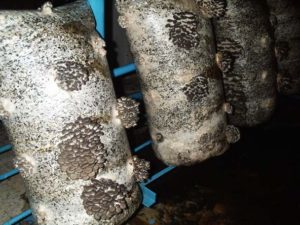
Content
What is mycelium
The mycelium is the vegetative body of the fungus, which is able to change its structure, depending on the environment, through the formation of special organs. It has thin processes that create a whole network of microscopic fibers.These fibers penetrate into a variety of structures (tree tissue, bark, roots), into the substrate, dead tissues of living organisms, etc., in order to receive useful and nutrient substances from there for their growth. Mycelium is a mother material that is produced from fungal spores in special laboratories. To understand more, it is worth taking a quick look at its structure.
- Vultures. These are the threads that penetrate the fertile surface (wood, plant roots, soil, substrate) and absorb all the minerals necessary for the growth of fungi.
- Sclerotia. Such a strange name was given to dense, solid neoplasms that arise as a result of changes in the vegetative body of fungi. This is a protective reaction of a microorganism to adverse conditions. Thus, it sinks into a hard capsule and is able to maintain its spores under adverse conditions.
- Stroma - small cocoons (mummies) separated from the main body. These are small, dense formations that appear in the tissues of a plant infected with fungal mycelium. The stroma take part in the formation of new forms of mycelium.
These are the three main structural elements of the intermediate mycelium. There are other structural elements that the mycelium forms as a result of its germination in a certain soil and in a certain environment.
Features of growing oyster mushroom mycelium at home: advantages in comparison with buying ready-made
The technology of growing oyster mushroom mycelium from grain at home is very popular among amateur mushroom pickers.
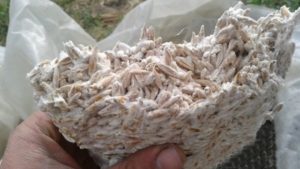
Oyster mushroom grain mycelium, as a rule, is made in specialized laboratories, under sterile conditions and at the required temperature. This gives a guarantee of quality, rapid growth and formation of myceliums. Naturally, the most productive will be the cultivation of oyster mushroom mycelium in special greenhouses, where all climatic conditions are observed, in the presence of high-quality, professional equipment and specially trained personnel. But it often happens that people who want to grow mushrooms on their own and in small quantities do not have the opportunity to acquire the mycelium of the desired type of mushrooms in their region.
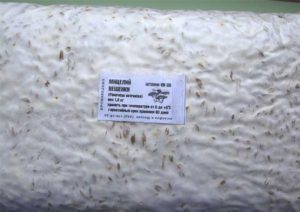
In such cases, it would be more rational to independently prepare oyster mushroom mycelium for home cultivation. The need for this may be due to the poor quality of the purchased material. This happens very often, because many intermediaries are aimed only at making a profit, without observing all the storage conditions. Such mycelium loses its properties and is not able to fully bear fruit. Therefore, more experienced mushroom growers prefer to prepare planting material on their own.
Based on this, there are several advantages of home production of oyster mushroom mycelium:
- First of all, it is the price. Whatever one may say, the material prepared on its own will cost much cheaper than the finished purchased one.
- You will be 100% sure of its quality, and in some cases, homemade mycelium is superior to laboratory one.
Only disadvantage home mycelium - long-term growth rate.
Home production technology:step-by-step instructions for growing oyster mushroom mycelium
Growing oyster mushroom mycelium at home will not be difficult. You need to be patient and faithful, as this is a long and laborious process. Most often, the vegetative body is bred on corrugated cardboard or on a tree, but this will require large areas and special conditions. The easiest way to grow good mycelium is on a cereal grain substrate - grain. This technology is used by most of the leading manufacturing companies.
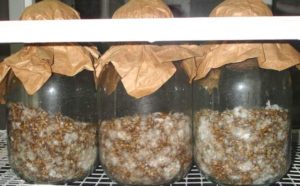
The whole process of obtaining oyster mushroom mycelium can be roughly divided into several stages.
Extraction of uterine mycelium
The uterine body (spores) is the basis for the origin and development of the mycelium as a whole. It is produced from the fruiting body of mushrooms, or rather from their upper part (cap).It is under the cap of the oyster mushroom that spores are found. For cultivation, only fresh mushrooms are used, without damage or disease.
Note! The most important thing in this business is sterility. It is necessary to completely exclude contact of the mycelium and the substrate with the environment. All instruments must be sterile, otherwise there is a great chance of bacteria growing in the substrate.
Here is a step-by-step instruction for obtaining oyster mushroom uterine mycelium.
- We cut the mushroom in half and, using tweezers, separate a small piece (it is best to choose the area closer to the cap).
- Next, you need to process this piece with hydrogen peroxide, in other words, disinfect it. Thus, we get rid of possible parasites or larvae that could be inside the fungus.
- Then the processed piece of oyster mushroom is placed in a test tube with crushed grain and tightly closed. Agar (carrot, potato, oat) can also be used as a substrate.
- Now it is necessary to leave the vessel for 2 weeks in a warm place, which does not get either drafts or direct sunlight.
Memo! The developing high-quality oyster mushroom mycelium looks like a fluffy white bloom with the aroma of freshly cut mushrooms.
Getting an intermediate mycelium
You can prepare the nutrient soil for growing uterine mycelium yourself. Oat or rye grains are excellent options.
Important! For the preparation of the substrate, you should not use two types of grains. When interacting with each other, they can ferment, and the uterine mycelium will disappear.
Step-by-step instructions for obtaining an intermediate mycelium:
- The grains are placed in a saucepan and poured with water so that the grain is covered by 3-4 centimeters, and boiled for half an hour.
- Next, the grain is filtered, dried and mixed with gypsum and lime.
- In the meantime, it is necessary to sterilize the jars (in the usual way, as for preservation).
- Then put the substrate in the jars by 2/3 (grain with gypsum and lime).
- Now you need to add the planting material obtained at the previous stage to the resulting substance.
- The results should be expected about 2 weeks, again leaving the jars in a warm room.
Important! If you notice that during the germination of the mycelium, dark spots and black dots began to appear on the grains, this means that foreign bacteria are present in the substrate. Most likely, the substrate or working tool was not sterile enough. Don't panic right away! Place the jars under the light of a quartz lamp for 24 hours, this will help kill all bacteria and prevent them from spreading further.
Step-by-step video tutorial on growing oyster mushroom mycelium at home
How to store oyster mushroom mycelium
It is not very difficult to store oyster mushroom mycelium, because it is not a perishable product.
At a temperature of + 1 ... + 5 C on the bottom shelf of the refrigerator (in winter it can be a basement) oyster mushroom mycelium can be stored for up to 1 year.
The mycelium can deteriorate at temperatures above + 30 ... + 32 C.
There are also 2 more ways to store oyster mushroom mycelium for a long time. The first is storage in a freezer at a temperature of -20 C, the second is its placement in liquid nitrogen. The second method is usually used in an industrial setting. Therefore, for home storage of oyster mushroom mycelium, it is necessary to use a freezer.
Note! Repeated thawing and subsequent freezing can damage the material.
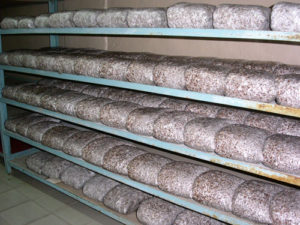
For more convenient storage, mycelium can be packaged in vacuum bags, which are pre-heat treated. They are placed in boiling water for 15 minutes, after which they are dried, and only then the seed itself is packaged in them. With such storage, you need to be especially careful. If you opened the package or its depressurization occurred due to rupture, it is urgent to land it, otherwise the mycelium will become unusable. There is no point in re-packing.
Video: how to properly store oyster mushroom mycelium
As it has already become clear, it is quite possible and very simple to grow oyster mushroom uterine mycelium at home. It takes a little patience and responsibility. The main thing is that you will be 100% sure of the quality of your own planting material. An important fact is that the cost of such a product will be three or even four times lower than that of the products of large mycelium production companies. By adhering to clear guidelines for mycelium production, you can grow quality intermediate material for oyster mushroom cultivation.
Video: how to make oyster mushroom grain mycelium at home

